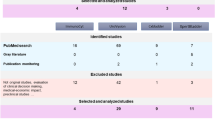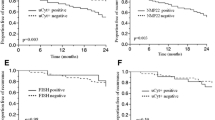Abstract
Purpose
Urinary cytology (C) and cystoscopy remain the gold standard for the detection and screening of bladder cancer (BC). In this prospective study, we analyzed whether baseline C, ImmunoCyt (I), BTA Stat (B), hemoglobin dipstick (H), and NMP22 BladderChek (N) can predict recurrence and progression.
Methods
Urinary samples from 91 patients with BC were prospectively collected over an 18-month period. Baseline characteristics of the population included patient demographics, various clinicopathological variables and use of intravesical therapy. Progression and recurrence were then assessed after a median follow-up of 48 months (IQR 23.7–59.5). Univariate and multivariate analyses were performed using COX proportional hazards models.
Results
On univariate analysis, C (HR 1.36; p = 0.26), I (HR 0.89; p = 0.66), B (HR 0.80; p = 0.42), H (HR 0.75; p = 0.30), and N (HR 0.82; p = 0.48) were not associated with recurrence-free survival (RFS). With regard to progression-free survival (PFS), C was significantly prognostic (HR 2.67; p = 0.017), whereas I, B, H, and N were not. On multivariable analysis, NMP22 was the only marker to be independently associated with RFS (HR 0.41, p < 0.01) and PFS (HR 0.32, p = 0.02).
Conclusion
Based on the results of this study, baseline C, B, I, and H were not independently prognostic. Prognostic impact of NMP22 requires further validation in a multicenter larger study.
Similar content being viewed by others
References
Canadian Cancer Society’s Advisory Committee on Cancer Statistics (2014) Canadian cancer statistics 2014. Canadian Cancer Society, Toronto. ISSN 0835-2976
Howlader N, Noone AM, Krapcho M, Garshell J, Miller D, Altekruse SF, Kosary CL, Yu M, Ruhl J, Tatalovich Z, Mariotto A, Lewis DR, Chen HS, Feuer EJ, Cronin KA (eds) (1975–2011) SEER cancer statistics review, National Cancer Institute. Bethesda. http://seer.cancer.gov/csr/1975_2011/. Based on Nov 2013 SEER data submission, posted to the SEER web site, Apr 2014
Burger M, Catto JW, Dalbagni G, Grossman HB, Herr H, Karakiewicz P, Kassouf W, Kiemeney LA, La Vecchia C, Shariat S, Lotan Y (2013) Epidemiology and risk factors of urothelial bladder cancer. Eur Urol 63:234–241
Rubben H, Lutzeyer W, Fischer N, Deutz F, Lagragne W, Giani G (1988) Natural history and treatment of low and high risk superficial bladder tumors. J Urol 139:283–285
Heney NM, Ahmed S, Flanagan MJ, Frable W, Corder MP, Hafermann MD, Hawkins IR (1983) Superficial bladder cancer: progression and recurrence. J Urol 130:1083–1086
Millan-Rodriguez F, Chechile-Toniolo G, Salvador-Bayarri J, Palou J, Algaba F, Vincent-Rodriguez J (2000) Primary superficial bladder cancer risk groups according to progression, mortality and recurrence. J Urol 164:680–684
Kassouf W, Kamat A, Zlotta A, Bochner BH, Moore R, So A, Izawa J, Rendon RA, Lacombe L, Aprikian AG (2010) Canadian guidelines for treatment of non-muscle invasive bladder cancer—a focus on intravesical therapy. Can Urol Assoc J 4(3):168–173
Hall CM, Chang SS, Dalbagni G, Pruthi RS, Seigne JD, Skinner EC, Wolf JS Jr, Schellhammer PF (2007) Guideline for the management of nonmuscle invasive bladder cancer: (stages Ta, T1 and Tis); update 2007. J Urol 178(6):2314–2330
Babjuk M, Bohle A, Burger M, Comperat E, Kaasinen E, Palou J, van Rhijn BWG, Roupret M, Shariat S, Sylvester R, Zigeuner R (2014) EAU guidelines on non-muscle-invasive bladder cancer (Ta, T1 and CIS); 2014. Eur Urol 65(3):778–792
Avritscher EB, Cooksley CD, Grossman HB, Sabichi AL, Hamblin L, Dinney CP, Elting LS (2006) Clinical model of lifetime cost of treating bladder cancer and associated complications. Urology 68:549–553
Yafi FA, Brimo F, Auger M, Aprkian A, Tanguay S, Kassouf W (2013) Is the performance of urinary cytology as high as reported historically? A contemporary analysis in the detection and surveillance of bladder cancer. Urol Oncol 32:e1–e6. doi:10.1016/j.urolonc.2012.09.011
Lotan Y, Roehrborn CG (2003) Sensitivity and specificity of commonly available bladder tumor markers versus cytology: results of a comprehensive literature review and meta-analyses. Urology 61:109–118, discussion 118
van Rhijn BW, van der Poel HG, van der Kwast TH (2005) Urine markers for bladder cancer surveillance: a systematic review. Eur Urol 47:736–748
Dey P (2004) Urinary markers of bladder carcinoma. Clin Chim Acta 340:57–65
Budman LI, Kassouf W, Steinberg JR (2008) Biomarkers for detection and surveillance of bladder cancer. Can Urol Assoc J 2:212–221
Yafi FA, Brimo F, Steinberg J, Aprikian AG, Tanguay S, Kassouf W (2014) Prospective analysis of sensitivity and specificity of urinary cytology and other urinary biomarkers for bladder cancer. Urol Oncol 33(2):66.e25–66.e31. doi:10.1016/j.urolonc.2014.06.008
Brimo F, Vollmer RT, Case B, Aprikian A, Kassouf W, Auger M (2009) Accuracy of urine cytology and the significance of an atypical category. Am J Clin Pathol 132:785–793. doi:10.1309/AJCPPRZLG9KT9AXL
Lopez-Beltran A, Montironi R (2004) Non-invasive urothelial neoplasms: according to the most recent WHO classification. Eur Urol 46:170–176
Lau P, Chin JL, Pautler S, Razvi H, Izawa JI (2009) NMP22 is predictive of recurrence in high-risk superficial bladder cancer patients. CUAJ 3:454–458
Salama RH, Selem TH, El-Gammal M, Elhagagy AE, Bakar SM (2013) Urinary tumor markers could predict survival in bladder carcinoma. Indian J Clin Biochem 28:265–271. doi:10.1007/s12291-012-0266-z
Todenhofer T, Hennenlotter J, Guttenberg P, Mohrhardt S, Kuehs U, Esser M, Aufderklamm S, Bier S, Harland N, Rausch S, Gakis G, Stenzl A, Schwentner C (2015) Prognostic relevance of positive urine markers in patients with negative cystoscopy during surveillance of bladder cancer. BMC Cancer 15:155–165. doi:10.1186/s12885-015-1089-0
Shahrokh SF, Savage C, Chromecki TF, Sun M, Scherr DS, Lee RK, Lughezzani G, Remzi M, Marberger MJ, Karakiewicz PI, Vickers AJ (2011) Assessing the clinical benefit of nuclear matrix protein 22 in the surveillance of patients with nonmuscle-invasive bladder cancer and negative cytology. Cancer 117:2892–2897. doi:10.1002/cncr.25903
Joung JY, Park S, Yoon H, Kwon WA, Cho IC, Seo HK, Chung J, Hwang SH, Lee CW, Lee KH (2013) Overestimation of nuclear matrix protein 22 in concentrated urine. J Urol 82:1059–1064. doi:10.1016/j.urology.2013.05.056
Miyake M, Goodison S, Giacoia EG, Rizwani W, Ross S, Rosser CJ (2012) Influencing factors on the NMP-22 urine assay: an experimental model. BMC Urol 12:23. doi:10.1186/1471-2490-12-23
Todenhofer T, Hennenlotter J, Kuhs U, Tews V, Gakis G, Aufderklamm S, Stenzl A, Schwentner C (2012) Influence of urinary tract instrumentation and inflammation on the performance of urine markers for the detection of bladder cancer. J Urol 79:620–624. doi:10.1016/j.urology.2011.10.067
Todenhofer T, Hennenlotter J, Tews V, Gakis G, Aufderklamm S, Kuehs U, Stenzl A, Schwentner C (2013) Impact of different grades of microscopic hematuria on the performance of urine-based markers for the detection of urothelial carcinoma. Urol Oncol 31:1148–1154. doi:10.1016/j.urolonc.2011.10.011
Onal B, Unsal H, Yilmaz S, Koybasioglu F, Altug U (2014) The use of urinary nuclear matrix protein 22 (NMP22) as a diagnostic adjunct to urine cytology for monitoring of recurrent bladder cancer—institutional experience and review. Diagn Cytopahtol 43:307–314. doi:10.1002/dc.23239
Kamat AM, Briggman J, Urbauer DL, Svatek R, Gonzalez GMN, Anderson R, Grossman HB, Prat F, Dinney CP (2015) Cytokine panel for response to intravesical therapy (CyPRIT): nomogram of changes in urinary cytokine levels predicts patient response to bacillus Calmette-Guerin. Eur Urol. doi:10.1016/j.eururo.2015.06.023
Kamat AM, Dickstein RJ, Messetti F, Anderson R, Pretzsch SM, Gonzalez GN, Katz RL, Khanna A, Zaidi T, Wu X, Grossman HB, Dinney CP (2012) Use of fluorescence in situ hybridization to predict patient response to BCG therapy for bladder cancer: results of a prospective trial. J Urol 187:862–867. doi:10.1016/j.juro.2011.10.144
Authors’ contribution
M.D. Bell was involved in data collection and data analysis and wrote the manuscript. F.A. Yafi, F. Brimo, J. Steinberg, A.G. Aprikian, and S. Tanguay were involved in data collection. W. Kassouf was involved in project development and data collection and edited the manuscript.
Author information
Authors and Affiliations
Corresponding author
Ethics declarations
Conflict of interest
The authors declare that they have no conflict of interest.
Informed consent
This study met the ethical standards of our internal review board, and informed consent was obtained from all patients prior to inclusion.
Rights and permissions
About this article
Cite this article
Bell, M.D., Yafi, F.A., Brimo, F. et al. Prognostic value of urinary cytology and other biomarkers for recurrence and progression in bladder cancer: a prospective study. World J Urol 34, 1405–1409 (2016). https://doi.org/10.1007/s00345-016-1795-5
Received:
Accepted:
Published:
Issue Date:
DOI: https://doi.org/10.1007/s00345-016-1795-5




